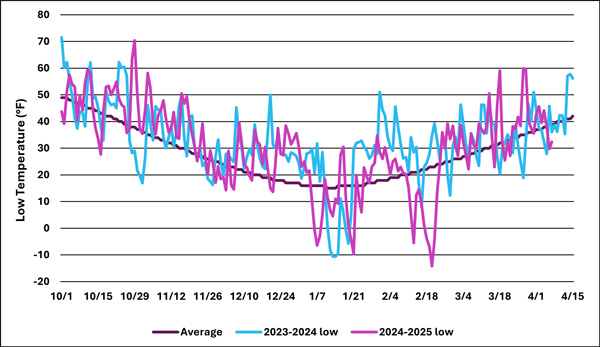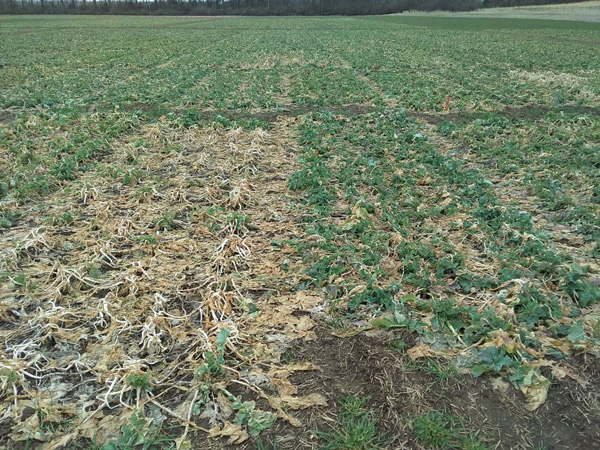The 2024-2025 winter canola crop is gearing up for the race to the finish. Recent observations indicate the majority of the crop survived the winter. However, with nearly all the state under abnormally dry to moderate drought conditions, the greatest concern right now is timely precipitation. Peak water demand is nearing as the crop is entering the reproductive stage.
To better understand how the current drought conditions are impacting canola, we think back to establishment conditions last fall. Across most of Kansas, limited soil moisture in the planting zone made establishment challenging or effectively delayed it until precipitation arrived. Winter canola needs to emerge promptly to attain adequate top growth going into the colder months. Fortunately, after late September rains fell, the crop emerged quickly after planting. Rainfall in early November and some snow cover helped sustain it over winter.
Winter temperatures in 2025 were colder on average in January and February than last year. Figure 1 shows the daily low temperatures from October to mid-April for Manhattan in the past two growing seasons. We cannot rely on snow cover to aid the overwintering of canola every year. But snow cover was very beneficial to survival during two bitterly cold stretches in January and February, especially near Manhattan. Also, the bitter temperatures arrived when the crop was fully acclimated and the most tolerant to the cold. As a result, limited winterkill was observed, even where snow wasn’t always present. Some differential winterkill was observed at the North Central Experiment Field near Belleville and at Ashland Bottoms near Manhattan. Figure 2 shows differences in winter survival in hybrids evaluated near Manhattan. The hybrid on the left is not well adapted and was prone to excessive fall growth, resulting in growing point elevation and eventual winterkill. The hybrid on the right possessed a more prostrate growth habit, leaving the growing point at a more protected position at the soil surface. Most of the winterkill observed this year was caused by elevated crowns above the soil surface, brought on by too much fall growth. Some winterkill in research trials is essential for selecting and advancing better-surviving materials.

Figure 1. Low temperatures near Manhattan, KS for the fall and winter months of the 2023-2024 and 2024-2025 growing seasons. Data courtesy of the Kansas Mesonet.

Figure 2. Differential winterkill observed in winter canola near Manhattan, KS. Photo by Mike Stamm.
Fortunately, the low temperature did not cause a significant reduction in the amount of above-ground biomass. The above-ground biomass was reduced, but not to a large extent, because the warm fall allowed for greater than average biomass accumulation. In addition, where snow was present, biomass was better preserved over the winter. In simple terms, canola yield and leaf area work hand-in-hand. Typically, in the years where we carry the most leaf area through the winter, we see greater potential for high yields. In the years where we lose most of the fall leaf area we can often see lower yields. The crop retained sufficient biomass this spring to produce a strong yield if moisture conditions improve.
Only time will tell how well the current canola crop will yield. We’ve seen the resiliency of canola carry it through challenging weather conditions before, and one significant rainfall event can change the narrative rather quickly.
Mike Stamm, Canola Breeder
mjstamm@ksu.edu
Tags: canola winter canola